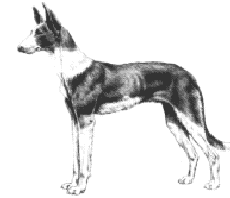Ibizan Hound
General Infofmation - Ibizan Hound

Group:
Hound
Size:
large
Lifespan:
12-14 years
Exercise:
medium
Grooming:
very low
Trainability:
Low
Watchdog ability:
high
Protection ability:
very low
Area of Origin:
Ibiza (Balaeric
Islands)
Date of Origin:
ancient times
Other Names:
Podenco Ibicenco,
Ca Eibisenc, Balaeric Dog
Original Function:
hunting rabbits
History
The Ibizan Hound, also known as the Podenco Ibicenco or the Balearic Dog, originates from the Balearic Island of Ibiza, Spain and is an ancient dog whose ancestors probably came from Egypt, dating back to 3000-3400 BC. where it hunted with the Pharaohs. It spread to mainland Spain and to southern France as well. Its main task was to hunt rabbits; with its large ears held erect when alert, this hound hunts by sound, as well as sight and scent.
Temperament
The Ibizan Hound is proud, sensitive, loyal, intelligent, and adaptable to many situations. It is a very active and alert dog, better suited to rural living; however, with proper exercise it can also thrive in an urban environment. Males may not get along well with each other.
Upkeep
As an independent and athletic dog, the Ibizan Hound needs daily exercise in a safe area. Ideal exercise allows the dog to stretch out at full speed, but its needs can also be met with long walks or jogs on leash, combined with an occasional chance to run full out. The Ibizan is not generally kept as an outside dog, although it can live outdoors in temperate climates given warm shelter and soft bedding. It is a skilled jumper, which should be taken into consideration when designing an enclosure. The smooth coat requires only occasional brushing, whereas the wire coat requires weekly brushing as well as occasional hand-plucking of dead hairs.
Ibizan Hound
A breed standard is the guideline which describes the ideal characteristics, temperament, and appearance of a breed and ensures that the breed is fit for function with soundness essential. Breeders and judges should at all times be careful to avoid obvious conditions and exaggerations, as well as being mindful of features which could be detrimental in any way to the health, welfare or soundness of this breed.
Breed Standard - Ibizan Hound
 Characteristics
Characteristics: A tireless controlled hunter. Retrieves to hand, very kind, rather cautious with strangers, has the ability to jump great heights without take:off run. An agile hound.
General Appearance: Tall, narrow, finely built, large erect ears.
Head and Skull: Fine, long flat skull with prominent occiputal bone. Stop not well defined, slightly convex muzzle, the length of which from the eyes to the tip of the nose should be equal to the length from the eyes to the occiput. Nose flesh coloured, should protrude beyond the teeth, jaw very strong and lean.
Eyes: Clear amber, expressive. Almond shaped; not prominent, large or round.
Ears: Large, thin, stiff, highly mobile, erect when dog is alert, in a continuous line with the arch of the neck when viewed in profile; base set on level with the eyes.
Mouth: Perfectly even white teeth; scissor bite; thin lips.
Neck: Very lean, long, muscular and slightly arched with no dew:lap.
Forequarters: Rather steep short shoulder blade, long straight legs, erect pasterns of good length.
Body: Level back sloping slightly from the pinbones to the rump. Long, flat ribcage. Short coupled with well tucked up waist, breast bone very prominent. Depth measured between the bottom of the ribcage and elbow 6 to 7.5 cm (2.5 to 3 in).
Hindquarters: Long, strong, straight and lean, no great angulation, long second thigh, turning neither in nor out .
Feet: Well arched toes, thick pads, light coloured claws. Front feet may turn slightly outwards. Dew claws should not be removed in front. No hind dew claws.
Gait: A suspended trot, which is a long far reaching stride, with a slight hover before placing the foot to the ground .
Tail: Long, thin, low set, reaching well below the hock, when passed between the legs and round the flank should reach the spine; may be carried high when excited but not curled within itself or low over the back.
Coat: Either smooth or rough, always hard, close, dense. Longer under the tail and at the back of the legs. Hunting scars should not be penalised.
Colour: White, Chestnut, or Lion solid colour, or any combination of these.
Weight and Size: The Standard in the country of origin varies between 56 and 74 cm (22 - 29 in), but balance is the overriding factor.
Faults: Any departure from the foregoing, the degree of the departure stipulating the seriousness of the fault.
Note: Male animals should have two apparently normal testicles fully descended into the scrotum.
DNZ No 474
Copyright Dogs New Zealand
01 Jan 2002
Any departure from the foregoing points should be considered a fault and the seriousness with which the fault should be regarded should be in exact proportion to its degree and its effect upon the health and welfare of the dog and on the dog’s ability to perform its traditional work.




